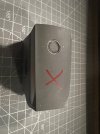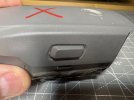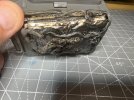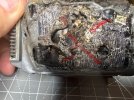Known bad Mavic battery caught fire and melted. Very scary. It was a known bad battery and I had it in LiPo Safe. I was straightening up and pulled the battery out to check on it. I ended up dropping it and it began to smoke. I threw it outside. Good lesson on the dangers of LiPo's.
You are using an out of date browser. It may not display this or other websites correctly.
You should upgrade or use an alternative browser.
You should upgrade or use an alternative browser.
Battery Meltdown (non-explosion)
- Thread starter MHFlexer
- Start date
- Joined
- May 25, 2017
- Messages
- 8,491
- Reactions
- 7,976
- Age
- 61
Goes to show how important correct recycling of these are.
Imagine that in a rubbish pick up truck, crushed in the back ?
First I've read about a DJI battery going up, even an older known end of life one.
The chemicals must have been very volatile for a knock to set off a runaway.
Imagine that in a rubbish pick up truck, crushed in the back ?
First I've read about a DJI battery going up, even an older known end of life one.
The chemicals must have been very volatile for a knock to set off a runaway.
I've seen meltdowns like that with cell phones and computer batteries, but never our DJI batts.Known bad Mavic battery caught fire and melted. Very scary. It was a known bad battery and I had it in LiPo Safe. I was straightening up and pulled the battery out to check on it. I ended up dropping it and it began to smoke. I threw it outside. Good lesson on the dangers of LiPo's.
If it was a known bad battery, it would be prudent to soak it in salt water for a few days to safely and completely discharge it. This is DJI's recommendation for safely disposing of end of life batteries.
PHZ
Well-Known Member
M2 batteries from DJI had serious issues early on. Swelling while in flight and blowing themselves out of the drone. I have gone through about four of them. They just develop a bulge on the bottom of the battery, sometimes early in their life. Disappointed in DJI in this matter.
I'm glad they seem to have found improved battery chemistry. I've only been flying since Dec. '22 and I'm on my 3rd DJI drone and - so far - no swelling or burst batteries. I have returned a couple for replacements for reported errors and DJI took care of it right away - paying for air freight shipping both ways.M2 batteries from DJI had serious issues early on. Swelling while in flight and blowing themselves out of the drone. I have gone through about four of them. They just develop a bulge on the bottom of the battery, sometimes early in their life. Disappointed in DJI in this matter.
Can you share any pictures of this?M2 batteries from DJI had serious issues early on. Swelling while in flight and blowing themselves out of the drone. I have gone through about four of them. They just develop a bulge on the bottom of the battery, sometimes early in their life. Disappointed in DJI in this matter.
I would like to see them, bottom of battery, where you turn it on?
Rod ..
Mrprop365
Well-Known Member
Was this a DJI brand battery and if it wasn't do I have to be concerned about this from DJI brand batteries???Known bad Mavic battery caught fire and melted. Very scary. It was a known bad battery and I had it in LiPo Safe. I was straightening up and pulled the battery out to check on it. I ended up dropping it and it began to smoke. I threw it outside. Good lesson on the dangers of LiPo's.
- Joined
- May 25, 2017
- Messages
- 8,491
- Reactions
- 7,976
- Age
- 61
If it was a known bad battery, it would be prudent to soak it in salt water for a few days to safely and completely discharge it. This is DJI's recommendation for safely disposing of end of life batteries.
Can you share any link to the DJI advice ?
While I've read numerous posts about using salt water to fully discharge lithium batteries, there are concerns about salt water and the effect on the battery connections / wires / chemistry.
This is to do with EVs and salt water storm damaged vehicles of late . . .
There ARE online sources advising this for our lipo batteries end of life, such as NextFPV
But then I trust this FPV pilots advice highly . . . Oscar Laing
He says chemicals reactions could cause issues, but it is deemed to be a relatively safe method with the battery fully immersed in cold fluid.
Thankful if ever needed, most recycling centres in Australia have special lithium battery sections to drop off anything suspect / old equipment.
I am not sure I would keep or store a "known bad battery", but glad you are ok and did not have major property loss.
From the Matrice 30 Maintenance manual:Can you share any link to the DJI advice ?
While I've read numerous posts about using salt water to fully discharge lithium batteries, there are concerns about salt water and the effect on the battery connections / wires / chemistry.
This is to do with EVs and salt water storm damaged vehicles of late . . .
There ARE online sources advising this for our lipo batteries end of life, such as NextFPV
But then I trust this FPV pilots advice highly . . . Oscar Laing
He says chemicals reactions could cause issues, but it is deemed to be a relatively safe method with the battery fully immersed in cold fluid.
Thankful if ever needed, most recycling centres in Australia have special lithium battery sections to drop off anything suspect / old equipment.
Battery Disposal
1. Make sure to remove the protective plastic sheet on the side of the battery before fully immerse the battery in an insulated bucket with 5% salt solution. Leave the battery in the solution for more than 48 hours to fully discharge the battery.
Insulated = non conductive, like plastic.
Cymruflyer
Well-Known Member
I had three batteries go bad on my M2Pro and DJI did replace them. The swelling starts on the bottom flat surface of the battery. Click it out of your drone and move it straight to the counter top in the same position (i.e. the flat bottom of the battery, not the top section where the on/off button and lights are).Can you share any pictures of this?
I would like to see them, bottom of battery, where you turn it on?
Rod ..
If it's swollen you will be able to easily spin it around, like a top. It will easily wobble around on that flat counter top. DJI asked for photos of all six sides plus a video showing it wobbling and easily spinning, along with a photo of the serial number. You can't mistake a swollen battery.
If you are unsure, just turn your battery on it's back, button and lights side down. Then get a metal ruler and put the edge of it on the battery's bottom and flat side. If you see no light along that ruler, then your battery bottom is flat and not swollen. If you can see light at the two edges on the ruler when the ruler edge is touching the centre of the battery bottom, then you clearly have a swollen battery.
- Joined
- May 25, 2017
- Messages
- 8,491
- Reactions
- 7,976
- Age
- 61
From the Matrice 30 Maintenance manual:
Battery Disposal
1. Make sure to remove the protective plastic sheet on the side of the battery before fully immerse the battery in an insulated bucket with 5% salt solution. Leave the battery in the solution for more than 48 hours to fully discharge the battery.
Insulated = non conductive, like plastic.
Indeed, never read (or knew) the M30 and perhaps other larger drones have so many manuals !
https://dl.djicdn.com/downloads/mat...trice30_Series_Maintenance_Manual_V1.0_EN.pdf
Page 10.
I haven't seen that in any regular DJI consumer drone manuals.
From the Matrice 30 Maintenance manual:
Battery Disposal
1. Make sure to remove the protective plastic sheet on the side of the battery before fully immerse the battery in an insulated bucket with 5% salt solution. Leave the battery in the solution for more than 48 hours to fully discharge the battery.
Insulated = non conductive, like plastic.
...But then I trust this FPV pilots advice highly . . . Oscar Laing
He says chemicals reactions could cause issues...
Have only had one 6S quad LiPo pack gone bad & taken out of flight duty... tested to discharge it with the salt water method.
Once in the water it started to bubble quite a lot around the XT60 connector & the balance lead connectors. After a couple minutes all connectors was severely green/black corroded which effectively made the conductivity worse. Let the pack lay there for 2 days anyway.
When I started the discharge the cell voltage was 3,8V... after 2 days in the water they had 0,1V. That was pretty good I thought but drove a nail through it anyway just to see if 0,1V/cell could set something off anyway.
Pretty immediately after the nail had shorted the cells the pack swelled up & spewed out a lot of black smoke & the outer plastic wrapping started to melt... no visible flames though. After like an hour the smoke had stopped & I could barely touch the warm battery. Snipped off the XT60 & wired up the negative & positive together & nothing happened, the battery was dead for real.
So... nah, the water method alone doesn't make the battery safe so you can throw it away in the garbage.
The battery mentioned in DJIs maintenance was a TB30 battery that has an opening that can be uncovered to make sure water penetrates the battery. Does your 6S battery have something similar? I'm just trying to decide if DJI is full of crap or we're comparing apples and oranges.Have only had one 6S quad LiPo pack gone bad & taken out of flight duty... tested to discharge it with the salt water method.
Once in the water it started to bubble quite a lot around the XT60 connector & the balance lead connectors. After a couple minutes all connectors was severely green/black corroded which effectively made the conductivity worse. Let the pack lay there for 2 days anyway.
When I started the discharge the cell voltage was 3,8V... after 2 days in the water they had 0,1V. That was pretty good I thought but drove a nail through it anyway just to see if 0,1V/cell could set something off anyway.
Pretty immediately after the nail had shorted the cells the pack swelled up & spewed out a lot of black smoke & the outer plastic wrapping started to melt... no visible flames though. After like an hour the smoke had stopped & I could barely touch the warm battery. Snipped off the XT60 & wired up the negative & positive together & nothing happened, the battery was dead for real.
So... nah, the water method alone doesn't make the battery safe so you can throw it away in the garbage.
The Enterprise drones are so much larger and have really big batteries that can be a hazard. I'm not surprised they are more cautious. Yes, I have manuals for updates, known issues, the battery charger itself which regularly gets firmware updates!Indeed, never read (or knew) the M30 and perhaps other larger drones have so many manuals !
https://dl.djicdn.com/downloads/mat...trice30_Series_Maintenance_Manual_V1.0_EN.pdf
Page 10.
I haven't seen that in any regular DJI consumer drone manuals.
I guess up until now, people just took their old lithium batteries to the hazardous waste disposal. I would like to see more information in our consumer drones. I learned a lot after I bought the Matrice 30 after flying my Air 2S and Mavic 3.
Of course, the goal is to drain the voltage of the battery to zero before disposal.
One reason salt water is recommended is because of the amount of conductivity, not because of a chemical reaction with chemicals in the battery... so the salt water does not have to penetrate the battery pack. Think of it as a low conductivity short.
Soaking the battery in saltwater just makes a low conductivity connection between the positive and negative posts. Same result would be achieved by connecting a light bulb of the right voltage between positive and negative, or a wire with a resistor of the right value... but most people don't own a soldering iron, a multimeter, or know anything about resistor values, so saltwater is recommended because salt is a common household item.
Distilled water has practically zero conductivity - no minerals.
City drinking water would have more conductivity but not by much.
Well water would have more conductivity depending on the amount of mineral content... mine has a high mineral content so I have to change the cartridge on the whole house water filter often.
Pond water and rain or snow water would possibly have more conductivity than well water.
Saltwater has even more conductivity, depending on the amount of salt added.... but not conductive enough to create an electron dump and possibly a runaway reaction. Problem is, salt also corrodes the metal of the positive and negative posts and, as @slup found, decreases conductivity.
NEVER connect just a wire between positive and negative! A small gauge wire would just melt quickly, a large gauge wire would create a dead short and likely cause a runaway reaction... ie: smoke, fire, and probably explosion!
BTW, don't drive a nail through one either.
One reason salt water is recommended is because of the amount of conductivity, not because of a chemical reaction with chemicals in the battery... so the salt water does not have to penetrate the battery pack. Think of it as a low conductivity short.
Soaking the battery in saltwater just makes a low conductivity connection between the positive and negative posts. Same result would be achieved by connecting a light bulb of the right voltage between positive and negative, or a wire with a resistor of the right value... but most people don't own a soldering iron, a multimeter, or know anything about resistor values, so saltwater is recommended because salt is a common household item.
Distilled water has practically zero conductivity - no minerals.
City drinking water would have more conductivity but not by much.
Well water would have more conductivity depending on the amount of mineral content... mine has a high mineral content so I have to change the cartridge on the whole house water filter often.
Pond water and rain or snow water would possibly have more conductivity than well water.
Saltwater has even more conductivity, depending on the amount of salt added.... but not conductive enough to create an electron dump and possibly a runaway reaction. Problem is, salt also corrodes the metal of the positive and negative posts and, as @slup found, decreases conductivity.
NEVER connect just a wire between positive and negative! A small gauge wire would just melt quickly, a large gauge wire would create a dead short and likely cause a runaway reaction... ie: smoke, fire, and probably explosion!
BTW, don't drive a nail through one either.
Last edited:
The battery I tried the salt water method on was a generic hobby LiPo battery, like the one below...... a TB30 battery that has an opening that can be uncovered to make sure water penetrates the battery. Does your 6S battery have something similar?..
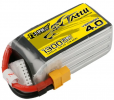
The inside of the TB30 battery looks the same, Lipo cells stacked & connected together... but in the DJI case then hidden inside a plastic box together with a BMS chip. So no difference when it comes to the LiPo cells alone. The opening you say exists on the TB30 isn't intended to let water in so the cells themselves can be penetrated by the water, each cell is closed & air tight, if they weren't the LiPo chemistry would be destroyed immediately when air enters. The only reason I can see to have an opening is to let water inside the plastic box & more easily reach the cell terminals & short out the battery.
So the same should occur with a TB30 battery as I saw on my generic battery... the terminals will quickly corrode & the conductivity will be low... making it hard to fully discharge the battery.
Last edited:
Battery came from eBay and it was really puffed up. I marked it with a red X and stored it in a LiPo bag. I am in my motor home with tile floors. I has taken it out of teh bag to take it to a disposal site. I dropped it onto the tile floor and it started hissing, threw it outside and it did the flame up and meltdown...Good thing that it wasn’t any worse and catch fire. Please explain though what you mean by “known” bad battery ? Was it something you just recently discovered, and put it in the safe? or had it been in the li-po safe for awhile and by chance, caught it at that time ?
eBay sellers are somewhat dangerous, had a Yuneec Typhoon H purchase and the battery in the aircraft was puffed up extending past the battery case. Returned the aircraft at that pint. Last, I saw another listing for a Yuneec battery and the picture in eBay showed the battery was also puffed up badly. I notified the seller he had a bad battery..
Similar threads
- Replies
- 34
- Views
- 2K
- Replies
- 34
- Views
- 3K
- Replies
- 1
- Views
- 1K
- Replies
- 32
- Views
- 2K
- Replies
- 8
- Views
- 1K
DJI Drone Deals
1. Mini 2
2. Mini 3 Pro
3. Mini 4 Pro
4. Air 2s
5. Air 3
6. Avata 2
7. Mavic 3 Pro
8. Mavic 3 Classic
2. Mini 3 Pro
3. Mini 4 Pro
4. Air 2s
5. Air 3
6. Avata 2
7. Mavic 3 Pro
8. Mavic 3 Classic
New Threads
-
-
3 Spring rain turn to snow in the mountain
- Started by alex_markov
- Replies: 0
-
-
-




